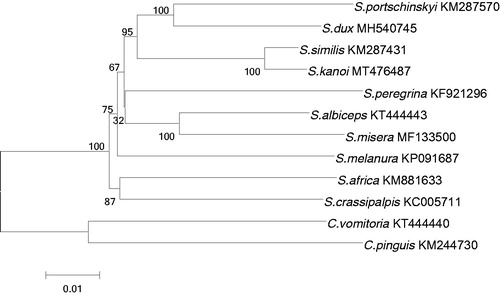Abstract
Sarcophaga kanoi Park, 1962, a widely distributed flesh fly in Southeast Asia, is important in forensic entomology. Notably, its mitochondrial genome could provide the unique and accurate molecular information in species identification which facilitate forensic practices in estimation of postmortem interval especially in putrefied cadaver cases. Thus, we sequenced and characterized the whole mitochondrial genome (mitogenome) of S. kanoi for the first time, which was collected from Southern China in this study. The 15,319 bp mitogenome contained 13 protein-coding genes (PCGs), 22 transfer RNA genes (tRNA), 2 ribosomal RNA genes (rRNA), and a putative control region. The total nucleotide composition of this circular genome was 39.7% for A, 9.3% for G, 14.2% for C, and 36.8% for T. To better understand the genetic relationship, the phylogenetic analysis was constructed according to the 13 PCGs sequence of S. kanoi and other 11 species. The phylogenetic tree showed that the S. kanoi was placed in a sub-clade with S. similis. Our study updated the new genetic information for dipteran mitogenomes, which could broaden the background knowledge for forensic entomology, molecular genetics and developmental biology. It has the potential application on the species identification using genetic markers.
Sarcophaga kanoi Park, 1962 (Roskov et al. Citation2017), a flesh fly distributed in Asia and Eastern Europe, has been reported presence in northwest, northeast and South-central China. It belongs to the Sarcophagidae family and Diptera order, which is a potential vector of human diseases. Currently, its density is increasing with the elevated levels of organic matter waste produced by human activities and animal breeding, which presents a worldwide health concern (Greenberg Citation1965). Moreover, its mitochondrial genome makes the essential contribution on the accurate postmortem interval (PMI) estimation in forensic entomology (Harrison Citation1989, Harvey et al. Citation2008). However, the complete mitogenome of S. kanoi has not been characterized previously. Therefore, we aim to identify the new genetic information. The sample collection of flesh fly was conducted in Hunan province, China. In this study, we firstly reported a whole mitogenome of S. kanoi (GenBank ID is MT476487).
The S. kanoi sample was collected at Changsha city, Hunan province, P. R. China (28.25°N, 112.55°E) in 9 November 2019. The flies were kept in the laboratory at −80 °C (Changsha, Hunan, China) with a sole code (CSU2020050791). The specimens were identified according to the key morphological characteristics. Subsequently, the genomic DNA was extracted using the QIANamp Micro DNA Kit as manual recommendation. The complete mitogenome was sequenced on an Illumina HiSeq 2500 Platform.
Using the MITObim V1.9 in de novo assembling and annotation, the assembled mitogenome was 15,319 bp in size. The heavy strand of the mitogenome molecule consisted of 39.7% adenine (A), 14.2% cytosine (C), 9.3% guanine (G) and 36.8% thymine (T). Totally, the mitogenome contained 13 genes encoding proteins of the respiratory chain, 22 tRNA genes and 2 rRNA genes, and a non-coding AT-rich region. The gene order of the mitogenome of S. kanoi was similar to that of other Sarcophagidae tribe whose sequence data are available.
To clarify the genetic relationship of S. kanoi with other sarcophagids species, 13 PCGs sequences of S. kanoi and other 11 sarcophagids species were chosen to calculate genetic distances and construct phylogenetic tree using the neighbor-joining method via the software MEGA 7.0 (Kumar et al. Citation2016). The results indicated that the S. kanoi was close to S. similis (genus Sarcophaga) in genetic relationship while Calliphora vomitoria and Chrysomya pinguis were selected as the root of phylogenetic tree (). The classification based on mitochondrial gene sequence is consistent with the results of traditional morphological classification. Our study updated the new genetic information for dipteran mitochondrial genomes, which could broaden the background knowledge for forensic entomology, molecular genetics and developmental biology. It is useful in evaluation of new genetic markers that have the potential application on the species identification.
Figure 1. Phylogenetic analyses of 12 sarcophagids species were constructed using NJ method based on 13 PCGs. Morphological species identification and GenBank ID were given in the label. Numbers on branches showed the bootstrap support value. The out-group consists of two species of Calliphora vomitoria and Chrysomya pinguis.

Disclosure statement
No potential conflict of interest was reported by the author(s).
Data availability statement
The data that support the findings of this study are openly available in GenBank at https://www.ncbi.nlm.nih.gov, reference number MT476487.
Additional information
Funding
References
- Greenberg B. 1965. Flies and disease. Sci Am. 213:92–99.
- Harrison RG. 1989. Animal mitochondrial DNA as a genetic marker in population and evolutionary biology. Trends Ecol Evol. 4(1):6–11.
- Harvey ML, Gaudier S, Villet MH, Dadour IR. 2008. A global study of forensically significant calliphorids: implications for identification. Forensic Sci Int. 177(1):66–76.
- Kumar S, Stecher G, Tamura K. 2016. MEGA7: molecular evolutionary genetics analysis version 7.0 for bigger datasets. Mol Biol Evol. 33(7):1870–1874.
- Roskov Y, Abucay L, Orrell T, Nicolson D, Bailly N, Kirk PM, Bourgoin T, DeWalt RE, Decock W, De Wever A, et al., eds. 2017. Species 2000 & ITIS Catalogue of Life, 27th February 2017. Digital resource at www.catalogueoflife.org/col. Species 2000: Naturalis, Leiden, the Netherlands. p. ISSN 2405–8858.
